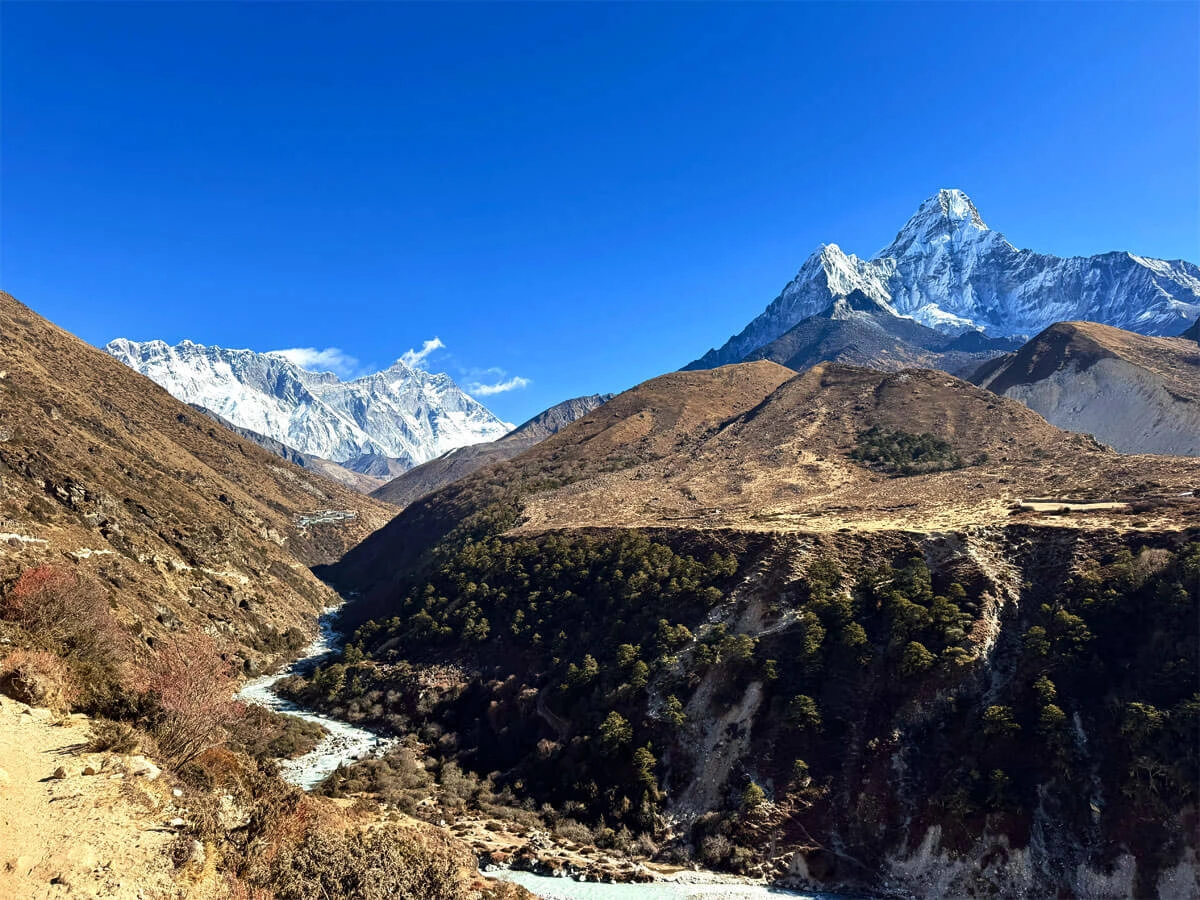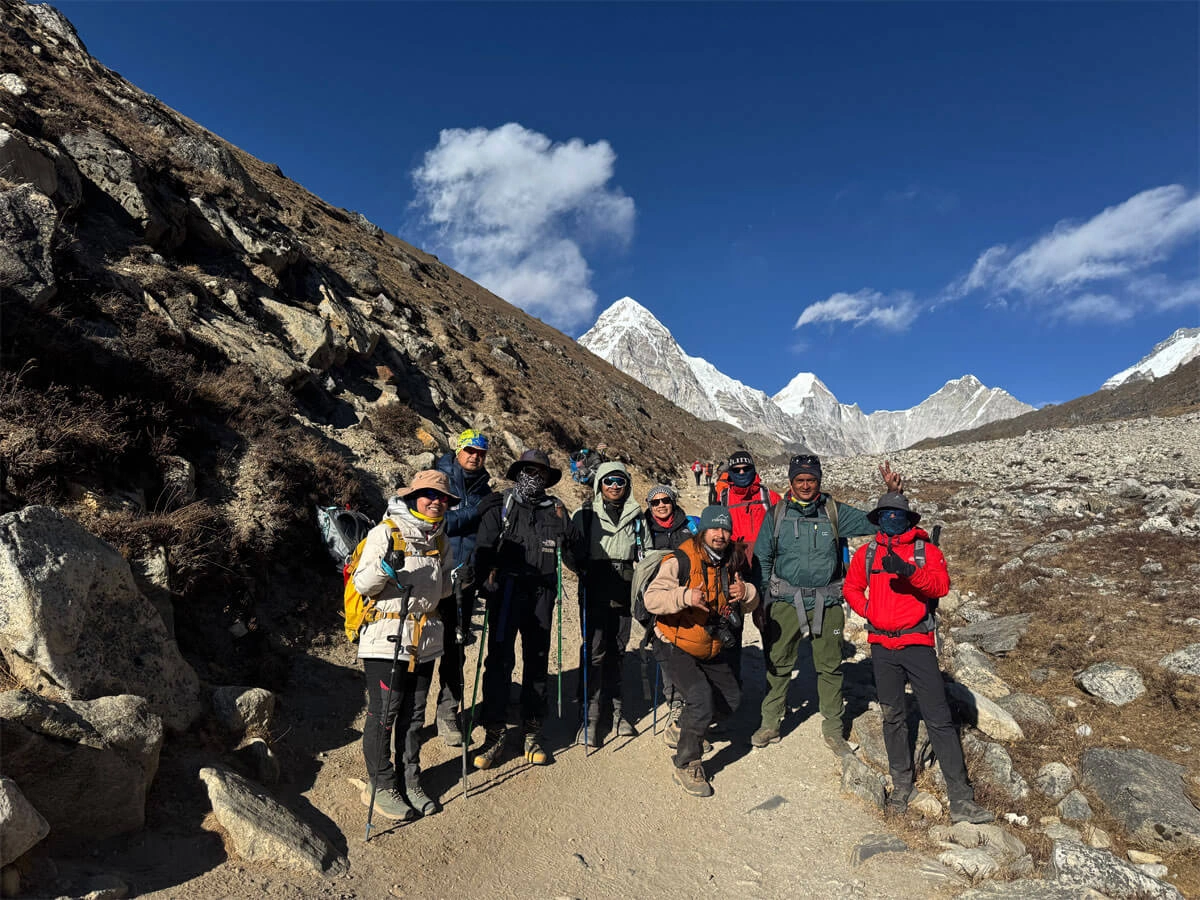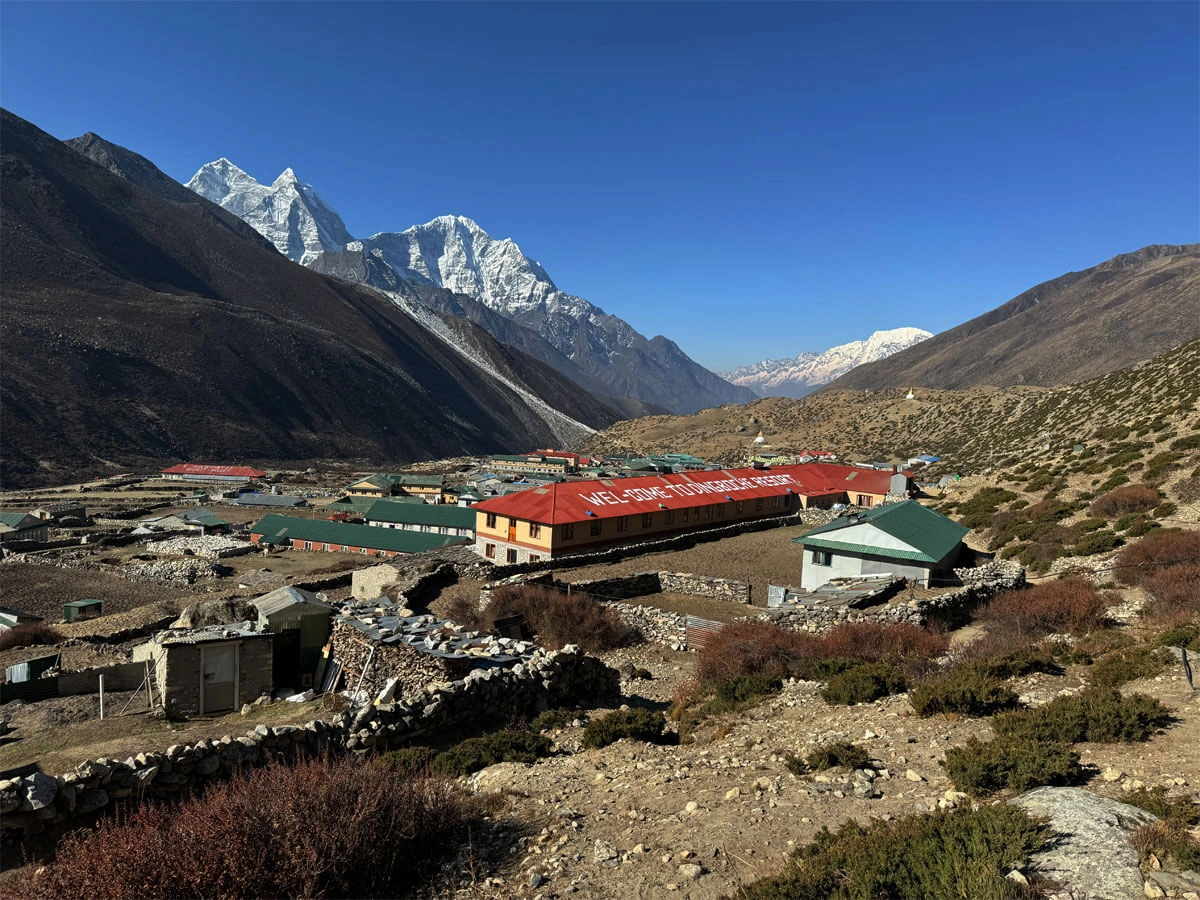Group Joins Departure dates of 2023:
7-Oct, 14-Oct, 21-Oct, 28-Oct, 4-Nov, 11-Nov, 18-Nov, 28-Nov, 2-Dec, 9-Dec, 16-Dec, and 24-Dec-2023.
The highlights of the trek :
- Stunning views of the world's highest peaks, such as Nuptse, Lhotse, and Everest.
- Trekking through the UNESCO-listed Sagarmatha National Park, which is known for its abundant biodiversity.
- Experiencing the distinctive culture and warm hospitality of the legendary sherpa community, which is known for mountaineering.
- Visiting traditional sherpa villages and monasteries along the trekking route, such as Namche Bazaar, and Tengboche.
- Crossing the thrilling suspension bridges over the Roaring rivers and deep gorges.
- Exploring the vibrant Rhododendron forests and encountering wildlife into extinction such as Musk deer and Himalayan Thar.
- Reaching the scenic viewpoint of the Kala Pathar(5545m), offering panoramic views of mountains.
- Experiencing the spiritual atmosphere of the ancient Buddhist monasteries, such as the Tengboche monastery.
- Wonder at Khumbu Ice Fall, a dangerous section of the Everest climbing route.
- Interaction with fellow trekkers from around the world, sharing stories, experiences and forging the connection.
- Indulging in delicious Nepalese Cuisine and traditional sherpa dishes, such as momos and Yak cheese.
- The vibrant Mani walls with Tibetan Buddhist prayer flags and inscriptions.
- Experiencing the thrill of reaching Everest base camp itself, standing at the foot of the World's highest mountain.
"Everest base camp: A Journey to the Roof of the World"
Picture yourself standing at the starting point of the legendary Everest base camp trekking, where dreams soar high and nature reveals its ancient secrets. Get ready for an incredible journey that takes you to the very footsteps of majestic Mount Everest. This experience unveils beautiful landscapes, showcases nature’s raw beauty, and captures the inspiring human determination.
As you begin to trek to Everest Base Camp, you’ll be surrounded by awe-inspiring scenery. Majestic peaks touch the endless sky while winding trails lead you through lush valleys filled with colorful flowers and fluttering prayer flags. Prepare to be embraced by the warm hospitality of the legendary Sherpa people whose vibrant culture adds richness to the Everest base camp trekking. Everest Base camp trekking makes you immerse yourself in local traditions, witness the harmonious blend of ancient wisdom and modern ways, and create cherished memories that will forever reside in your heart. The trails to Everest base camp pass through the serene mountain monasteries to thrilling high-altitude passes. This journey celebrates the personal triumph and the quest for beauty. Every breath you take in rarefied air is a tribute to nature’s magnificence, inviting you to blend in the symphony of the Himalayas.
So, lace up your boots, get through the gentle winds, and embark on this soul-stirring pilgrimage to the roof of the world, the Everest base camp. This extraordinary trek to Everest will become an interesting chapter of your life where your spirit flies high in the middle of the world’s highest peaks, where the ordinary becomes extraordinary, and where dreams seem real against the mighty Mount Everest.
Remember, this journey to Everest Base camp is not just a physical journey- it’s a transformative passage. It weaves you into this fabric of mystic land, leaving an everlasting impression that will forever resonate within you. Savor every step of this long and eventful journey to Everest, as you witness the majesty of the mountains and discover the untamed beauties that lie within yourself.
The Everest Base Camp trekking offers a remarkable journey through stunning landscapes, rich cultural encounters, and amazing views of the World’s highest mountains. With careful and scheduled acclimatization, each day will bring new adventures, creating an unforgettable experience that will leave you with a deep appreciation for the Himalayas.
Best time for Everest Base Camp Trekking
The best time to trek through the Everest Base Camp route is during the spring and autumn seasons. These seasons generally offer the most favorable weather and optimal trekking conditions. Here are the details:
Spring Season (March to May):
- Temperatures are mild, with pleasant daytime temperatures ranging from 10°C to 15°C (50°F to 59°F) at lower altitudes.
- Blooming rhododendron forests create a vibrant and colorful trekking environment.
- Clear skies and excellent visibility offer stunning views of the Himalayan peaks.
- It is a popular time for trekking, so expect more crowds on the trail.
Autumn Season (September to November):
- Stable weather conditions with dry and clear skies.
- Moderate temperatures during the day, ranging from 10°C to 20°C (50°F to 68°F) at lower altitudes. Spectacular views of the mountains with excellent visibility.
- The trail is less crowded compared to the spring season.
- Ideal for photography enthusiasts due to the clarity of the mountain vistas.
Both seasons have their advantages, and the choice between them depends on personal preferences. Spring offers the beauty of blooming flora, while autumn provides clearer skies and slightly cooler temperatures. It's important to note that weather conditions can vary, and it's always recommended to check the current weather forecasts and consult with local trekking agencies for the most up-to-date information before planning your Everest Base Camp trekking.
Geography of Everest
The Everest Base Camp route traverses diverse landscapes and altitudes, including Sagarmatha National Park, ranging from 2,800 meters (9,186 feet) to the towering heights of Mount Everest at 8,848 meters (29,029 feet). Along the way, trekkers follow the enchanting DudhKoshi River, explore the vibrant Sherpa culture in Namche Bazaar, visit the serene Tengboche Monastery at 3,870 meters (12,694 feet), witness the majestic Khumbu Glacier, ascend the rocky terrain of Kala Patthar at 5,545 meters (18,192 feet), and ultimately reach Everest Base Camp itself, nestled at 5,364 meters (17,598 feet). These geographical highlights create an extraordinary journey, showcasing lush forests, river valleys, rugged terrains, and icy landscapes, while providing breathtaking views of the world's highest peaks, making the Everest Base Camp trek an unforgettable adventure.
Culture and History
The Everest Base Camp route is rich in cultural heritage, predominantly influenced by the indigenous Sherpa community. Sherpas are renowned for their resilience, mountaineering expertise, and warm hospitality. They follow a unique blend of Tibetan Buddhism, evident in the numerous monasteries, prayer flags, and stone mani walls along the trail. Sherpa community maintains a deep reverence for the mountains, with spiritual practices woven into their daily lives. Traditional Sherpa attire, intricate handicrafts, and delicious local cuisine further showcase their cultural traditions. Interacting with the Sherpa people provides a glimpse into their ancient customs, religious rituals, and the immense respect they hold for the natural environment.
The history of the Everest Base Camp route is closely tied to the exploration and conquest of Mount Everest. The route gained prominence in 1953 when Sir Edmund Hillary of New Zealand and Tenzing Norgay, a Sherpa climber, successfully summited Everest for the first time. Following their historic ascent, the route gradually gained popularity among trekkers and mountaineers seeking to experience the awe-inspiring landscapes and the thrill of being in proximity to the world's highest peak. Over the years, the route has evolved to accommodate the growing number of adventurers, with improvements in infrastructure, lodges, and facilities. Today, the Everest Base Camp route stands as an iconic symbol of human endeavor and the remarkable achievements of mountaineering history, attracting enthusiasts from around the globe to embark on this unforgettable journey.
Why is the Everest Base Camp [EBC] trekking famous?
The Everest Base Camp trek is famous because it offers an unparalleled opportunity to witness the world's highest peak, experience stunning landscapes, immerse in Sherpa culture, achieve personal milestones, and embark on an adventure of a lifetime. It truly is an extraordinary and iconic trek that captivates the hearts and imaginations of adventurers from all corners of the globe.
Frequently Asked Questions
What is the duration of the Everest Base Camp trek?
The trek typically takes around 12-14 days, depending on the itinerary and acclimatization.
What is the highest point reached during the Everest Base Camp trek?
Kala Patthar, at an altitude of 5,545 meters (18,192 feet), offers the highest viewpoint on the trek.
Is previous trekking experience required for the Everest Base Camp trek?
While prior trekking experience is helpful, it is not essential. A good level of fitness and preparation is important.
What is the best time of year to do the Everest Base Camp trek?
The primary trekking seasons are spring (March to May) and autumn (September to November) for favorable weather and clear views.
Is altitude sickness a concern during the trek?
Yes, altitude sickness is a potential risk. Proper acclimatization, gradual ascent, and awareness of symptoms are crucial.
Are there teahouses or lodges available along the trekking route?
Yes, there are numerous teahouses and lodges that offer accommodation and meals along the Everest Base Camp route.
What permits are required for the Everest Base Camp trek?
Trekkers need to obtain the Sagarmatha National Park Permit and the TIMS (Trekkers' Information Management System) Card.
Is it possible to hire a guide or a porter for the trek?
Yes, hiring a guide or porter is a common practice and can be arranged through trekking agencies or independently.
What are the bathroom and shower facilities like during the trek?
Teahouses provide basic bathroom facilities, including squat toilets and shared showers with cold water.
Can I charge my electronic devices during the trek?
Yes, most teahouses offer charging facilities for a paid, either through electricity or solar power.
Is it possible to access Wi-Fi or a cellular network during the trek?
Wi-Fi and cellular network coverage are available at some teahouses along the trek, but it may be limited and intermittent.
Are there opportunities for side trips or additional summits during the trek?
Yes, side trips to places like Gokyo Lakes or Island Peak can be added to the itinerary for those seeking additional adventures.
What type of weather conditions should I expect during the trek?
Weather conditions can vary, but expect colder temperatures, especially at higher altitudes, with occasional rainfall or snowfall.
What type of clothing and gear should I bring for the Everest Base Camp trek?
Layered clothing suitable for various weather conditions, sturdy hiking boots, a warm sleeping bag, and a backpack are essential.
Is travel insurance necessary for the Everest Base Camp trek?
Yes, having comprehensive travel insurance that covers trekking and emergency evacuation is strongly recommended.
Note: Weather in Everest is unpredictable so there is a high chance of delays as well as cancellation of the scheduled flight. The rate of flight delays and cancellations is high at Lukla. During your journey, if flight cancellation happens you have to spend an extra night at Lukla/Ktm (if you are coming back to Kathmandu or going to Lukla). So, we request you to spare a couple of days if you are planning to trek in the Everest region so that you will not miss your international flight. Helicopter rescue can also be an option but it cost you more.




